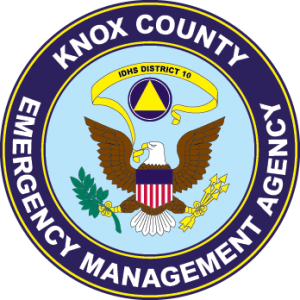Knox County Emergency Management Agency maintains and operates multiple Outdoor Warning Sirens throughout the county. It is important that citizens never rely on these sirens as a source of warning while indoors, even if a siren is nearby and easily heard indoors. These sirens are only meant for and designed to alert people who are outdoors and away from other sources of warning methods.
When a siren is sounded, that is a signal to go indoors immediately and check with other local sources for additional information (such as TV and radio).
Outdoor Warning Sirens are mostly activated for severe weather and testing, however, sirens can be activated for other emergencies such as hazardous material releases affecting a large area.
Sirens in the affected area will be activated for severe weather when at least one of the following occur:
- A Tornado Warning is issued inside Knox County
- A Trained Spotter confirms a funnel cloud or tornado
- A Public Safety official (Police, Fire, EMS, EMA) confirms a funnel cloud or tornado
- Outdoor Sirens will be activated for a Severe Thunderstorm Warning with a “DESTRUCTIVE” damage threat tag indicating 80 mph winds and/or hail of 2.75 inches or greater.
Knox County Outdoor Warning Sirens can be activated all at once, by zone (North, Central, South), or individually. By having this capability, sirens that are not in a threat area are not activated.
Storm Based Warnings
Severe Thunderstorm Warnings and Tornado Warnings are not issued based on whole counties. When the National Weather Service issues a Warning, the meteorologist will “draw” an area known as a polygon on their workstation for the affected areas. This polygon represents the actual Warning area. If you are inside the warning polygon, you should go to a safe location and monitor updates. If you are not in the polygon, you do not need to respond to the warning (but are encouraged to monitor and maintain awareness). Outdoor Warning Sirens will be activated based on the Storm-Based Warning polygon area. For more information on Storm-Based Warnings, click this link – NWS Storm Based Warnings
Other Warning Methods
As mentioned previously, it is crucial to never rely on sirens as a primary source of warning. Several factors may prevent sirens from activating such as power failure and electronic failure points. Other recommended warning methods include CodeRED, NOAA All-Hazards Weather Alert Radio, Wireless Emergency Alerts (WEA), Local Television, and Local Radio. It is strongly recommended to have multiple warning methods in case one should fail.
All Clear Tone
The Outdoor Warning Sirens do not give any “all clear” tones. When a siren is activated, it will sound for three (3) minutes before turning off automatically. It is important to remember that a siren turning off does NOT indicate that a threat is over. Monitor local media sources or NOAA Weather Radio for information on when a threat has ended.
Siren Testing
Outdoor Warning Sirens will be tested once a month at 11:30 AM from March through November on the first available Saturday with acceptable weather conditions.
Acceptable weather conditions will consist of cloud cover of less than 50%, air temperatures above 40ºF, no precipitation falling or nearby, no active Tornado or Severe Thunderstorm Watch, and no severe weather risk during the current Day 1 Outlook from the Storm Prediction Center (SPC).
Testing decisions will be communicated on our Facebook page – facebook.com/knoxcountyema





